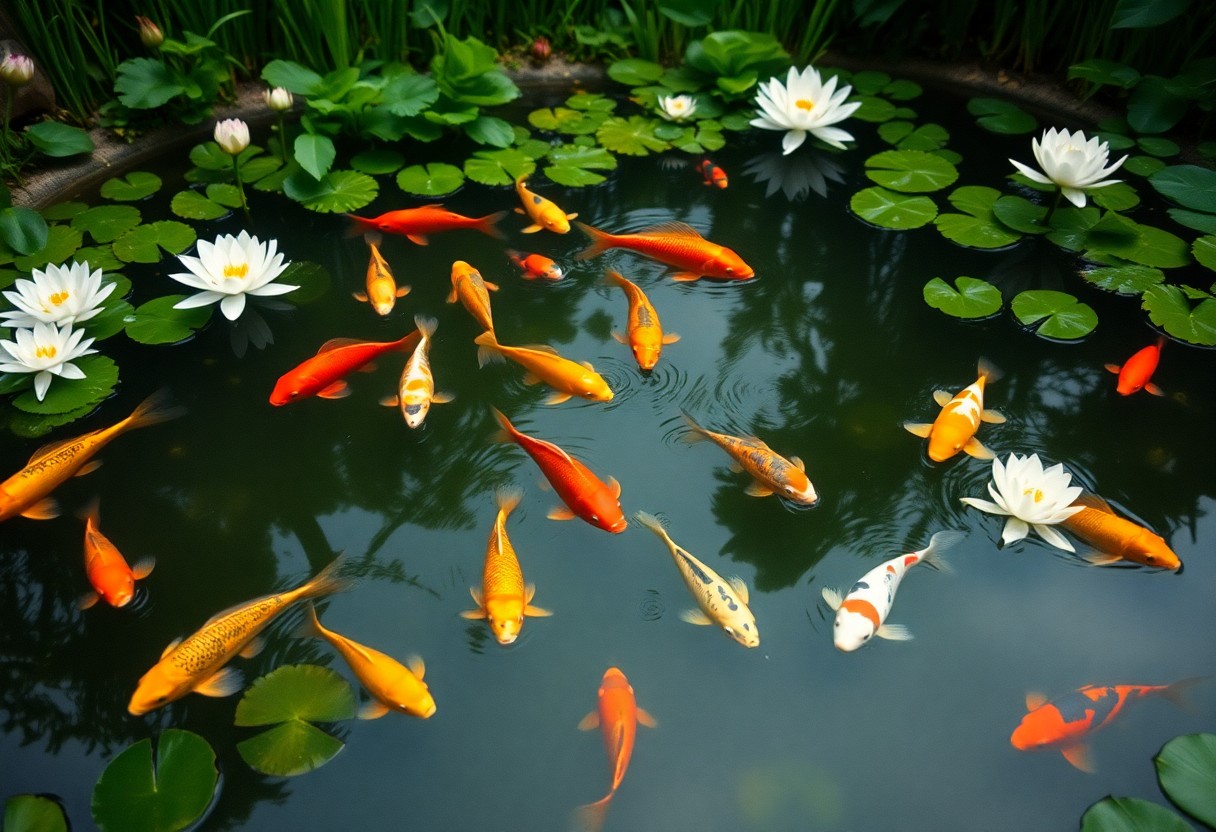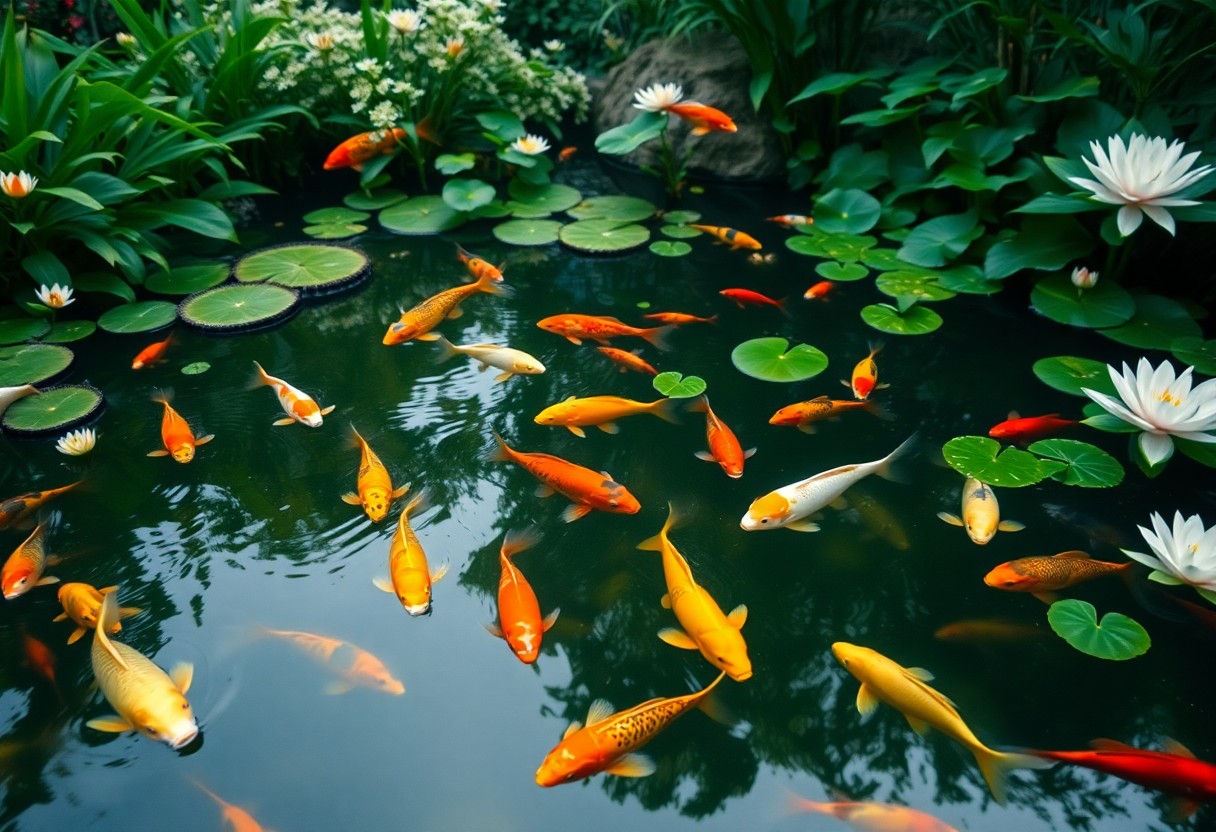This guide will help you determine how many fish to add to your pond for optimal health and balance. Overcrowding can lead to poor water quality and stressed fish, while too few can upset the ecosystem. You’ll learn to calculate your pond’s volume, consider fish species, and employ the one-inch per gallon rule for stocking levels. By understanding these factors, you can create a thriving aquatic environment that benefits both you and your fish.
Table of Contents
Key Takeaways:
- Begin by considering the size and depth of your pond, as these factors influence the appropriate fish stocking levels.
- Choose fish species that are compatible with each other to ensure a healthy ecosystem and minimize stress.
- Monitor water quality regularly, as this will help you determine if adjustments in fish numbers are necessary.
- Implement a gradual stocking strategy to prevent overloading the pond and allow the ecosystem to adjust.
- Consult local guidelines or experts on regional fish species to ensure a balanced and sustainable fish population.
Understanding Pond Capacity
Before you introduce fish to your pond, it’s vital to understand its capacity. Overcrowding can lead to poor water quality and stress among fish. To ensure a healthy ecosystem, you need to determine how many fish your pond can sustain while keeping them safe and comfortable. Balancing aquatic life requires precise calculations based on the pond’s size and water quality.
Surface Area Calculations
On a practical note, you should start by calculating the surface area of your pond. Measure its length and width, and then multiply those numbers to determine the total square footage. This measurement is crucial for estimating the maximum number of fish your pond can support, as it directly correlates with the oxygen supply and feeding area available.
Water Volume Assessment
Assuming you have determined the surface area, the next step is to assess the water volume of your pond. Accurately calculating the water volume allows you to understand the total environment in which your fish will live. You can determine volume by multiplying the surface area by the average depth of the pond. Knowing the volume will guide you in setting up a balanced population of fish.
Assessment of your pond’s volume is vital for maintaining a healthy habitat. Use the formula Volume = Surface Area × Average Depth to gain a precise understanding of the pond’s water capacity. A higher volume means more water for oxygen exchange and waste dilution, which is beneficial. However, if your pond is too shallow, oxygen depletion and increased toxicity can occur. This can lead to detrimental effects on your fish. Always aim to create a sustainable environment by matching the fish population to the available water volume.
Essential Water Quality Factors
Clearly, maintaining healthy water quality is vital to support your pond’s ecosystem. Key factors include:
- pH
- Temperature
- Oxygen levels
- Aeration
Assume that you regularly test these variables to create a balanced environment. For more guidance, check out How Many Fish Can You Add to Your Pond?
Oxygen Levels and Aeration
Oxygen is crucial for the survival of your fish. Adequate aeration improves oxygen levels, promoting a healthier environment.
pH and Temperature Requirements
The ideal pH level for most pond fish ranges from 6.5 to 8.5, while the acceptable temperature varies between 65°F to 75°F.
pH and Temperature Guidelines| Factor | Ideal Range |
| pH | 6.5 – 8.5 |
| Temperature | 65°F – 75°F |
Requirements for your pond’s water quality are critical for ensuring the well-being of your fish. Maintaining a stable pH and optimal temperature range protects against stress and disease. Regular monitoring and adjustments will fortify your pond’s ecosystem, so you can enjoy a healthy aquatic habitat.
Requirements Summary| Factor | Importance |
| pH | 6.5 – 8.5 to prevent fish stress |
| Temperature | Consistent conditions help fish thrive |
Fish Stocking Guidelines
For a balanced pond, it is important to follow fish stocking guidelines that ensure a sustainable aquatic ecosystem. You should consider factors such as pond size, existing wildlife, and the environmental conditions before adding fish. The right amount and species of fish not only enhance the beauty of your pond but also promote a healthy balance in the aquatic environment.
Fish Species Selection
Clearly, selecting the right fish species is important for achieving harmony in your pond. You should choose fish that complement each other and thrive in similar water conditions. Native species are often the best choice, as they are well adapted to local environments and help maintain ecological balance.
Size and Growth Considerations
Selection of fish size and understanding their growth patterns is important for a thriving pond ecosystem. You should choose fish that suit the dimensions of your pond and will not outgrow their space. Overcrowding can lead to stunted growth, increased competition for resources, and poor water quality.
Size considerations impact your pond’s overall health. You should select young fish that allow you to monitor their growth and health as they mature, ensuring that they can adapt well to your pond environment. Overstocking can lead to inadequate resources for each fish, contributing to poor water quality and disease outbreaks. Additionally, understanding the growth rates of various species can help you avoid rapid imbalances in the pond’s ecosystem. Strive for a mixture of sizes that allows for a balanced population and sustainable growth!
Calculating Stocking Density
Once again, understanding stocking density is integral to maintaining a balanced pond. Proper calculations involve considering both the size of your pond and the species of fish you intend to stock. By assessing these factors, you can achieve the ideal balance that promotes the healthy growth of fish while preventing overcrowding, which can lead to stress and diminished water quality.
Fish-per-Acre Ratios
On average, the recommended fish-per-acre ratio typically varies based on species and pond conditions. For instance, you might aim for about 100-200 bluegill or 50-100 bass per acre. Adjusting these values according to water quality, vegetation, and feeding practices will optimize the health and productivity of your pond.
Biomass Limitations
Limitations in biomass can significantly affect your pond’s ecosystem. Overloading your pond with fish can lead to increased waste production, which negatively impacts water quality and can lead to fish die-offs. Maintaining a balance ensures that both fish and the aquatic environment thrive.
FishperAcre guidelines suggest maintaining a biomass limit generally between 300-500 pounds of fish per acre. Exceeding this limit leads to harmful consequences, including oxygen depletion and heightened competition for resources. It’s imperative for you to monitor population densities closely and regularly assess your pond’s health indicators to ensure sustainable fishkeeping practices, thereby enhancing the overall vitality of your pond.

Monitoring and Management
Now that you’ve established the right number of fish in your pond, ongoing monitoring is key to maintaining a balanced aquatic ecosystem. Regular assessments of fish health, water quality, and algae growth will enable you to adjust your approach as needed. Be attentive to any signs of overpopulation or imbalance, which can jeopardize the health of your fish and the entire pond system.
Population Assessment Methods
The best way to assess your fish population is through methods such as visual observations, sampling, and catch-and-release techniques. This allows you to estimate the number and health of fish, ensuring their numbers remain within the desired range and are balanced in size and species.
Seasonal Adjustments
Adjustments should be made seasonally to account for changes in environmental conditions, such as temperature and spawning behaviors. These factors can influence fish growth rates and their food supply.
Monitoring the seasonal variations in your pond is necessary for effective management. During spring and summer, fish tend to grow faster and reproduce, so it’s wise to assess their population and health more frequently. If you notice overcrowding or increased competition for food, consider removing some fish to maintain balance. In the cooler months, fish activity declines, and feeding may reduce; thus, you can decrease your feeding regimen. Adapting your management practices throughout the year helps ensure a thriving pond ecosystem.
Common Stocking Mistakes
Your fish stocking plan can make or break the balance of your pond. Frequent errors include adding too many fish too quickly or ignoring the size and species compatibility of the fish you choose. To help you avoid these pitfalls, visit this link for insights on How Many Pond Fish Is Too Many Fish?. A well-researched plan will keep your pond healthy and thriving.
Overstocking Prevention
Now, to prevent overstocking, always calculate the appropriate number of fish based on your pond’s size and filtration capacity. Monitor their growth and behavior regularly to ensure they have enough space and resources to thrive.
Species Compatibility Issues
Little attention to species compatibility can lead to significant problems in your pond. Mixing aggressive fish with more peaceful species can result in stress and harm, compromising the overall health of your ecosystem.
It is vital to consider that some fish may prey on others, leading to a drastic decrease in population and potential imbalance. Additionally, disease can spread rapidly among incompatible species, putting your entire pond at risk. Prioritize compatibility by researching each fish’s temperament and environmental needs to maintain harmony in your pond’s ecosystem.
Conclusion
Presently, achieving a balanced pond requires thoughtful management of fish populations. You should assess your pond’s size, water quality, and existing aquatic life to determine the right number of fish to introduce. Regular monitoring and adjustment of your fish stocking can prevent overpopulation and maintain ecological harmony. By following these guidelines, you can create a thriving pond environment that supports both fish and the overall ecosystem.
FAQ
Q: How do I determine the right number of fish for my pond size?
A: The number of fish you can keep in your pond largely depends on its size. A common guideline is to allow for 1 inch of fish per gallon of water. For instance, if your pond holds 1,000 gallons, you can support approximately 100 inches of fish. Additionally, consider the adult size of the fish you plan to keep, as this will impact how many you can sustainably house.
Q: What factors should I consider when choosing fish for my pond?
A: When deciding on fish, consider several factors including the local climate, pond environment, fish compatibility, and your own preferences. Choose species that are well-adapted to your climate, ensure they can coexist peacefully, and think about what you want from your pond—whether it’s aesthetic beauty, recreational fishing, or a balance of both.
Q: How can I maintain a balanced ecosystem in my pond?
A: To maintain balance, it’s important to manage the fish population along with aquatic plants and decaying organic matter. Introduce plants that provide shelter, food, and spawning areas for fish. Regularly monitor water quality parameters such as pH, dissolved oxygen, and ammonia levels. Periodic testing can help in making adjustments to avoid overpopulation or nutrient overloads.
Q: What signs indicate that I may have too many fish in my pond?
A: Signs of overpopulation in your pond can include stunted growth in fish, an increase in waste accumulation, frequent algal blooms, and poor water quality. Fish may start to behave aggressively or compete for food more than usual. If you observe these signs, consider reducing the number of fish or improving the aeration and filtration systems.
Q: How often should I assess my fish population for balance?
A: It’s advisable to assess your fish population at least twice a year—preferably in spring and fall when temperatures are moderate. During these assessments, check fish health, reproduction rates, and any environmental changes in the pond. This practice will help you stay informed and make timely adjustments if necessary to maintain a healthy pond ecosystem.

